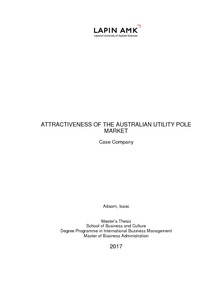ATTRACTIVENESS OF THE AUSTRALIAN UTILITY POLE MARKET : Case Company
Adaam, Isaac (2017)
Adaam, Isaac
Lapin ammattikorkeakoulu
2017
All rights reserved
Julkaisun pysyvä osoite on
https://urn.fi/URN:NBN:fi:amk-2017082314513
https://urn.fi/URN:NBN:fi:amk-2017082314513
Tiivistelmä
The objective of this thesis was to assess the attractiveness of the Australian utility pole market from the perspective of the case company. A business intelligence influenced the interest about wood poles in Australia. The intelligence predicted the need for new utility poles to replace the existing ones that had reached their usage period. The case company which produces treated wood poles for international markets required this assessment before making a decision on pursuing the Australian market.
The research method which was a case study approach, utilised qualitative data from both primary and secondary sources to assess the attractiveness of the market. The assessment is conducted under three main segments, i.e. market situation, competitive landscape, and microenvironment factors. Under each of these segments, various variables were considered to present the market from different angles. Relevant literature, focused on International market selection and International market attractiveness, was analysed to understand the theoretical underpinnings of the selection of Australia and choice of variables for the assessment.
The results and analysis of the study concluded on the Australian market not to be an attractive one for two main reasons. Firstly, despite the existing poles reaching their usage time, a new national decision supports the reinforcement these old poles instead of replacing them. As a result, the eminent demand has shifted to the next five to ten years. Secondly, the presence of a strong competitor with better competitive advantages might present some tough impediments. The study, therefore, recommends that the case company shelve plans of targeting the Australian market for the next five to ten years during which the reinforced poles would have reached their usage time. Within that period however, the company could either explore opportunities other than the wood pole business or focus on building business relations to gain further knowledge about the market.
The research method which was a case study approach, utilised qualitative data from both primary and secondary sources to assess the attractiveness of the market. The assessment is conducted under three main segments, i.e. market situation, competitive landscape, and microenvironment factors. Under each of these segments, various variables were considered to present the market from different angles. Relevant literature, focused on International market selection and International market attractiveness, was analysed to understand the theoretical underpinnings of the selection of Australia and choice of variables for the assessment.
The results and analysis of the study concluded on the Australian market not to be an attractive one for two main reasons. Firstly, despite the existing poles reaching their usage time, a new national decision supports the reinforcement these old poles instead of replacing them. As a result, the eminent demand has shifted to the next five to ten years. Secondly, the presence of a strong competitor with better competitive advantages might present some tough impediments. The study, therefore, recommends that the case company shelve plans of targeting the Australian market for the next five to ten years during which the reinforced poles would have reached their usage time. Within that period however, the company could either explore opportunities other than the wood pole business or focus on building business relations to gain further knowledge about the market.
